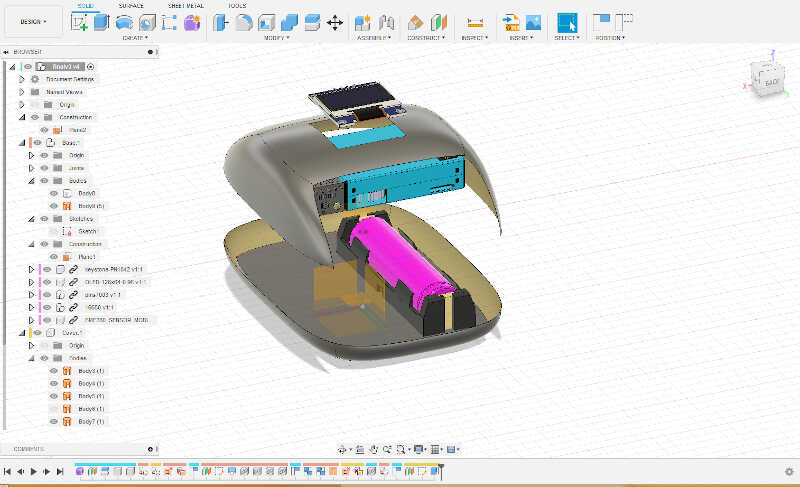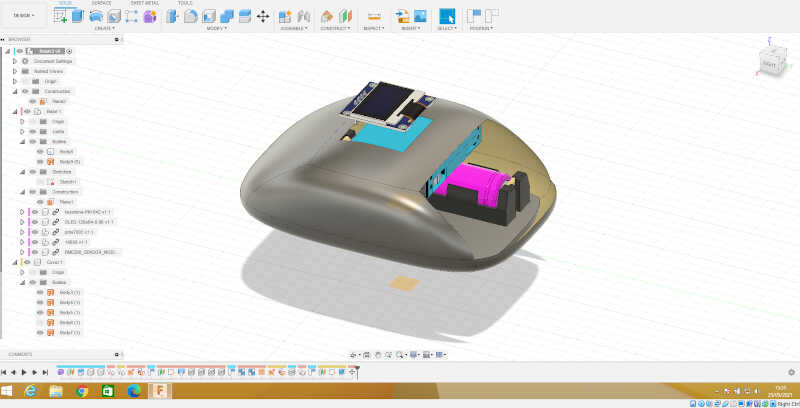16. Applications and implications¶
Assignment¶
Propose a final project masterpiece that integrates the range of units covered, answering:
- What will it do?
- Who’s done what beforehand?
- What will you design?
- What materials and components will be used?
- Where will come from?
- How much will they cost?
- What parts and systems will be made?
- What processes will be used?
- What questions need to be answered?
- How will it be evaluated?
- Your project should incorporate 2D and 3D design, additive and subtractive fabrication processes, electronics design and production, embedded microcontroller interfacing and programming, system integration and packaging. - Where possible, you should make rather than buy the parts of your project. - Projects can be separate or joint, but need to show individual mastery of the skills, and be independently operable.
After some thought, and considering all the experiences from the course and due to limited time, I decided to restrict my final project to one module. At this time it will not be possible to do a modular ecosystem, as expected.
Therefore I will concentrate my efforts on one of the modules: the on-the-go bike mobile environmental monitor.
Here I will briefly answer the questions and detail them in the project page.
1. What will it do?¶
The bike mobile environmental monitor will measure the on-the-go concentration of the particulate matter in the air, as well as humidity, temperature and pressure. It will also track its position via a gps module.
The information will be send via LORa with MQTT packages to a cloud server. An online dashboard will be available to monitor and analyze the data in real time.
The device will have a 16650 battery that will be charged wirelessly via induction power.
2. Who’s done that beforehand?¶
There are many open source projects on air quality monitoring but some are not mobile. For instance:
- Sensor Community. The latest version of an air quality (PM) and noise monitoring project, originally developed by luftdaten.info a project stemming from the OK Lab Stuttgart. I work with these sensors in project MAPEAR and my project ideia is to improve on them.
- Smart Citizen project. An initiative from Fablab Barcelona that took off globally, in a similar fashion as the Sensor Community project. They have three main products:
- A more affordable smart citizen kit (~ 110 euro) that contains a PM counter, VOC and CO_2 sensors. It also measures weather conditions, noise pollution, and light pollution.
- The smart citizen kit 2.1, which incorporates the smart citizen kit capabilities plus precisely measures Carbon Mononixe (CO), Nitrogen Dioxide (NO2), Ozone (O3) with electrochemical sensors.
- The platform that displays in real time the measurements made all over the world.
- The almabike branch project I found out recently. It is very similar to the one I’m developing.
- Air Casting from Habitat Map. It is a mobile and fixed mapping PM sensing with an online platform. It didn’t took off for now. I tested their platform to track positon with the phone but there were crashing problems.
-
Open Seneca. A very similar project, also doing bike measurements, but it is not clear if it is open source hardware or just open source software.
-
There are many projects that had the duration of the funding period (e.g.):
- There are also some previous (non-exhaustive!) air quality projects made in Fablab Academy:
- 2019
- Project Canary by Annie Ferlatte (not sure she finished it). Measures PMs. I guess she wants the wings to move according to the value of the PM (?).
- PM Air quality sensor by Lucas Lim. Measures PM concentrations for wood workshop.
- 2018
- NaviGaire by Tanja Lovric. Measures indoors VOC to give a measure of air quality.
- Air Quality Controlled Window Opener by Bergbora Bjorgvinsdóttir. It senses Voc and then translates to equivalent CO2.
- Pollution Sensor Calibration Unit by Óscar González Fernández.
- 2017
- Plant.air by Ana Filipa Silva. A plant pot that measures indoor CO2.
- 2019
3. What will you design?¶
I’ll design a portable air quality sensor, based on particulate matter measurement. The following picture shows an early design with some components more or less in place.

And here I have a picture with the box closed.

4. What materials and components will be used?¶
- Sensor Case
- The case will be done with Mayku Formbox using a CNC machined mold. In principle a transparent or opaque material will be used.
- Sensor base
- The base will be mostly 3d printed with PLA. There may be a laser cut acrylic part to show the inductive coil.
- Components
- Receiver inductive coil from Adafruit.
- 16650 lithium battery with keystone-PN1042 holder.
- BME280 Temperature, Humidity and Pressure sensor module.
- Plantower PMS 7003 Particulate matter sensor (PM1, PM2.5, PM10)
- HoperF RMF96W IC module to add to the final PCB.
- Electronic components: capacitors, resistors, regulators, LEDs, diodes…
- U-blox NEO-6M GPS module.
5. Where it will come from?¶
Most materials come from the lab itself. Some have been bought in mauser, mouser and farnell . Also, I already had a few of the modules I will use.
6. How much do they cost?¶
Here I will make a preliminary BOM to estimate the price of the whole thing.
| Part | Cost (euro) | link |
|---|---|---|
| Inductive coil pair 5V @ 500mA | 8.20 | link |
| 16650 Battery | 7.45 | link |
| Keystone PN1042 Battery holder | 2,94 | link |
| OLED Display 0.96’‘ I2C 128x64 SSD1306 White | 4,54 | link |
| NEO6Mv2 GPS module | 5,90 | link |
| BME280 Temp/Humi/Pressure module | 5,68 | link |
| PMS 7003 PM Sensor | 23,89 | link |
| RFM96W LORA IC | 14,00 | link |
| ESP32-WROOM-32E (16MB) | 2,98 | link |
| Electronic parts and components (FR1, resistors, condensers, switches, regulators, diodes, pins, buttons…) | 10,00 | estimated |
| 12V Charger | 4,92 | link |
| PLA plastic | 5,00 | estimated |
| Thermoforming sheet | 1,00 | estimated |
| Acrylic laser cut part | 1,00 | estimated |
Grand Total: 97,50 €
7. What parts and systems will be made?¶
I will fabricate:
-
Electronic PCB with ESP32 IC and LORA IC RMF96W. I will base my design in the one made on week 12.
-
Part of the case cover with the thermoforming machine, using a mold made with the CNC cutting machine.
-
Case base and part of the cover with the 3d printing.
-
Part of the base with the laser cutting machine.
-
Embedded interface with a node-RED dashboard on the cloud (for now).
-
Embedded programming integrating all inputs/outputs.
8. What processes will be used.¶
Vacuum forming, 3d printing, laser cutting, cnc cutting, electronics production, embedded interfacing and programming.
9. What questions need to be answered?¶
-
What is the air quality of our cities?
-
How can we continuously monitor everything, so that we have a better idea of the quality of the air that we breathe?
-
How can we use this information to influence public policies and to raise public awareness?
-
How can we involve the public in this process? How to create communities of practice around air quality issues?
-
How can we involve the public in citizen science practices?
10. How it will be evaluated?¶
For evaluation I will use the following strategies:
- Analysis of the output values (PMs, temperature, humidity, pressure, coordinates, LORA signal) and comparison with similar devices/projects to check their viability. There will be a Node-RED dashboard to monitor the output values.
- Extensive on-the-bike all-weather testing.